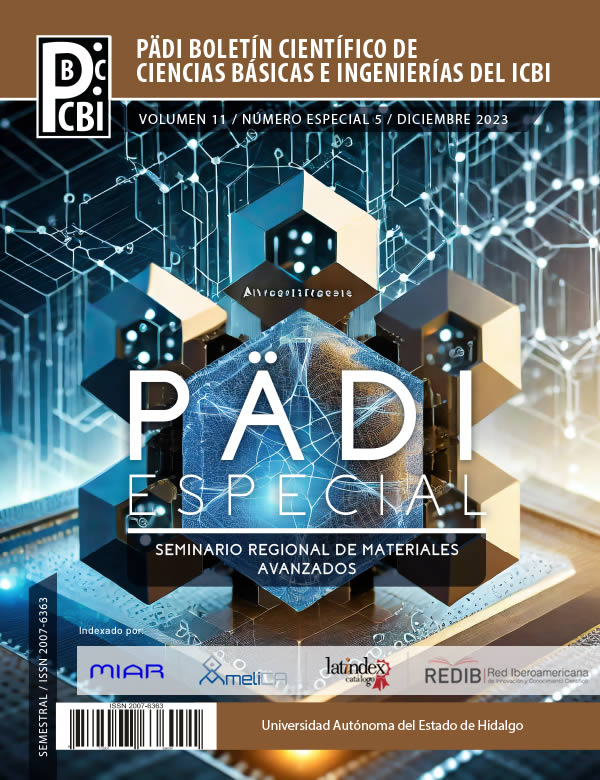Determinación de resistencia a la compresión en concretos con jales
Resumen
Los residuos mineros son considerados un riesgo ambiental y de salud debido a su alto potencial como generador de drenaje ácido además de la presencia de elementos potencialmente tóxicos (EPTs). En este trabajo se elaboraron probetas de concreto con sustituciones de cemento con jales mineros provenientes de la Presa Dos Carlos del estado de Hidalgo al 10, 20 y 30% en peso. Las muestras de jales se analizaron por diferentes metodologías como digestiones, pruebas químicas y potencial de neutralización para conocer las EPTs, sus propiedades y alcalinidad que tienen estos residuos. Las probetas de concreto se sometieron a pruebas de compresión para analizar su resistencia. Los resultados demostraron que estos residuos contienen Pb, As, Cr, Ag y Se, confirmando el riesgo latente en los jales mineros. Con respecto a la resistencia de las probetas con sustitución con jales al 10%, los resultados fueron satisfactorios en comparación con el 20 y 30%.
Descargas
Citas
Al-Mufti, R. L., & Fried, A. (2018). Non-destructive evaluation of reclaimed asphalt cement concrete. European Journal of Environmental and Civil Engineering, 22(6), 770-782. https://doi.org/10.1080/19648189.2016.1219877
Armienta María Aurora., Villaseñor Cabral G., y Romero Francisco Martin, (2005). Propuesta de estrategia metodológica para la evaluación de la peligrosidad de jales mineros en México. AIMMGM XXVI Convención Internacional de Minería, Veracruz, Ver.
Flores, J., Hernández, J., Salinas, E., Pérez, M., Rivera, I., Mireles, I., & Cerecedo, E. (2015). PREPARACIÓN DE BLOQUES A PARTIR DE RELAVES. Soluciones de Ingeniería para la Sostenibilidad: Materiales y Recursos II.
Hernández-Acosta, E., Mondragón-Romero, E., Cristobal-Acevedo, D., Rubiños-Panta, J. E., & Robledo-Santoyo, E.. (2009). Vegetación, residuos de mina y elementos potencialmente tóxicos de un jal de Pachuca, Hidalgo, México. Revista Chapingo serie ciencias forestales y del ambiente, 15(2), 109-114. Recuperado en 24 de septiembre de 2023, de http://www.scielo.org.mx/scielo.php?script=sci_arttext&pid=S2007-40182009000200004&lng=es&tlng=es.
Lawrence, R.W. and Wang, Y. (1997), Determination of neutralization potential in the prediction of acid rock drainage. Proc. 4th. International Conference on Acid Rock Drainage, Vancouver, B.C., May 30-June 6, 1997.
Moreno, R., Monroy, M., & Castañeda, E. P. (2009). Evaluación geoquímica de residuos mineros (jales o colas) de mineralización de tipo epitermal, Hidalgo, México. Revista geológica de América central. https://doi.org/10.15517/rgac.v0i41.4180
Romero, Francisco Martín, & Gutiérrez Ruíz, Margarita. (2010). Estudio comparativo de la peligrosidad de jales en dos zonas mineras localizadas en el sur y centro de México. Boletín de la Sociedad Geológica Mexicana, 62(1), 43-53. Recuperado en 24 de septiembre de 2023, de http://www.scielo.org.mx/scielo.php?script=sci_arttext&pid=S1405-33222010000100004&lng=es&tlng=es.
Secretaria de Economía, (s. f.). Minería. https://www.gob.mx/se/acciones-y-programas/minerianúmero volumen, números de página.
DOI: 10.3923/ijbc.2010.190.202
Solís-Carcaño, Rómel Gilberto, & Alcocer-Fraga, Miguel Angel. (2019). Durabilidad del concreto con agregados de alta absorción. Ingeniería, investigación y tecnología, 20(4), 00003. Epub 15 de noviembre de 2019.https://doi.org/10.22201/fi.25940732e.2019.20n4.039
Volpi-León, V. (2017). Corrosion Study in Reinforced Concrete Made with Mine Waste as Mineral Additive. International Journal of Electrochemical Science, 22-31. https://doi.org/10.20964/2017.01.08
Derechos de autor 2023 Melissa Gordillo-Salazar, Màrius Ramírez-Cardona, Alexander López-González, Ángel Ruiz-Sánchez, Julio César Juárez-Tapia, Erick de Jesús Muñoz-Hernández

Esta obra está bajo licencia internacional Creative Commons Reconocimiento-NoComercial-SinObrasDerivadas 4.0.













